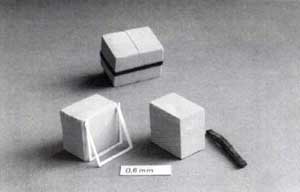Oblog, Piotr:
Badania nad techno logią zapraw do wypełniania rys i przyklejania
łuszczących się fragmentów kamieni.
The investigation into mortar technology of filling cracks and gluing
flaking fragments
2000
zum Download
Beteiligte, Autor/inn/en:

11. l. Budowa próbki sandwiczowej. Dystans 0,6 mm
The studies of available injection masses were to recognize their physical and mechanical properties and check their suitability for the conservation of flaking stone surfaces. Four injection masses were examined. Three of them: Ledan TBl, Malta 600 I and Malta 6002 compose of mineral binders and were produced for conservation of wall paintings, the protection of loosening frescos. The fourth, Funcosil Steinfestiger VM 857 is a silicoorganic product produced particularly for conservation of historical stone objects. As a comparative material, samples of the SmH6w sandstone were used. The examination started with checking what prop01tion of make-up water I dry mortar (and in the case of Steinfestiger's binder) I aggregate lead to achieving the optimal consistence and injection abilities of the abovementioned masses. Having selected injection masses of the best properties, the study of crack filling abilities was examined. In order to standardise examination conditions of particular injection masses, crack models of defined sizes were constructed. After the masses had been injected, bonded and seasoned. the degree of filling artificial cracks was studied. The masses, which bad reached the most promising results, were then subject to the assessment of adherence, capillary pulling-up, and frost-resistance. Due to the fact that it is impossible to fotm injection masses in cubes or norm beams (big contraction of masses), the models of cracks, hereinafter referred to as sandwich samples, were filled with particular products. Investigation results Too low capillary properties should be considered the biggest fault of the studied injection masses (with regard to sandstone parameters). Due to insufficient capillary properties injection masses: Ledan TB I (with 0.88 part of make-up water to I part of dry mortar). Malta 6001 (0,71 part of water). and Funcosil Steinfestiger VM857 (according to the recipe) should be used in filling the cracks and gluing the flaking Jl·agments of historical objects exposed to direct interaction with atmospheric factors (particular water). They are made of stone of the same capillruy properties with the Smil6w sandstone that was used as a comparative material.
The remaining mass properties - injection abilities, easy penetration of cracks and base adherence - lead to conclusion that they may be used in conservation of stone objects preserved in stable conditions. It seems that funher investigations to determine injection masses of physical and mechanical properties suited for stone cannot exclude attempts to modify certain product parameters, particularly capillary properties.
Polish Essay with English abstract from the book
Korzeniowski,Tomasz (wyd.): Materialy II, Ogólnopolskiej Konferencji Naukowej Studentów Konserwacji Zabytków,Torun, 24 - 26 lutego 2000 r., Tom II, Torun 2000 (= Studenci o konserwacji 2)
Volltext zum Download (pdf-Format, ca. 6.79 MB)
 Dieses Werk steht unter einer
Creative Commons BY-NC-ND 3.0 Deutschland Lizenz.
Dieses Werk steht unter einer
Creative Commons BY-NC-ND 3.0 Deutschland Lizenz.

![]() Dieses Werk steht unter einer
Creative Commons BY-NC-ND 3.0 Deutschland Lizenz.
Dieses Werk steht unter einer
Creative Commons BY-NC-ND 3.0 Deutschland Lizenz.